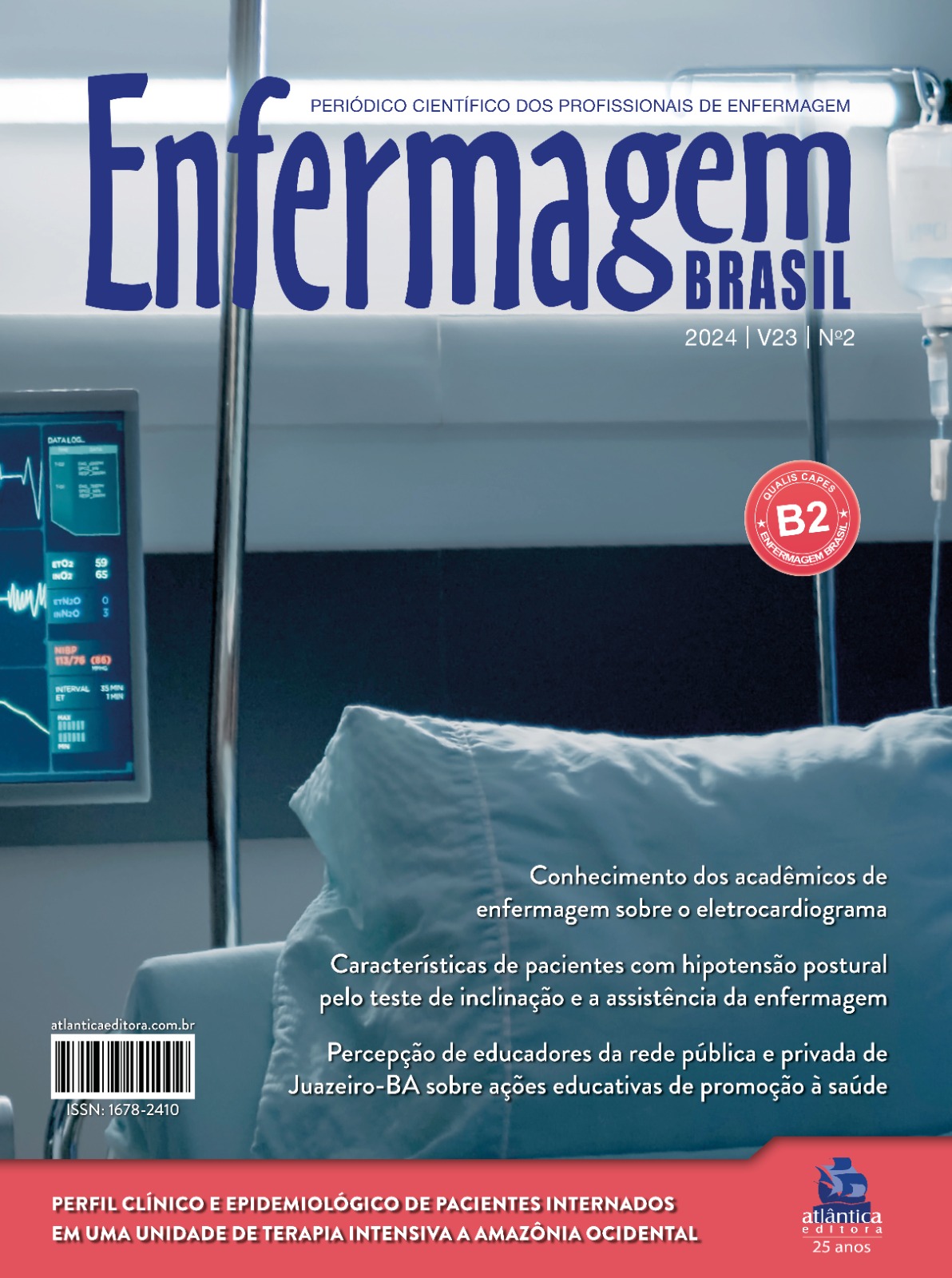Epidemiological characterization of patients admitted to the Acre reference intensive care unit in 2020
DOI:
https://doi.org/10.62827/eb.v23i2.4010Keywords:
Intensive care units; epidemiology; mortality.Abstract
Objective: To describe the epidemiological profile of patients admitted to the Intensive Care Unit of the Urgency and Emergency Hospital in Rio Branco, Acre state. Methods: This is a descriptive, retrospective and documentary field study with a quantitative approach based on data from patient records admitted between January 2020 and December 2020. Data collection was carried out on 869 medical records, which were used as the study's sampling space. Results: It was observed that males predominated at admission, 60.07% (522) were male, while 39.93% (347) were female. The average age was 56.6 years. When dividing the elderly and adults, it was found that the elderly accounted for 47.87% (416) of the patients. Among the types of ventilation used on the patients, the most commonly used was mechanical ventilation 63.5% (558). When comparing the type of ventilation with the outcome of care, mechanical ventilation resulted in 70.4% (393) of patients dying and only 27.2% (153) being discharged alive. When analyzing the relationship between gender and outcome, males had a higher prevalence of discharges 59.8% (219), deaths 60.3% (279) and transfers 60% (24). The most frequent outcome was death 52.7% (463), followed by discharge 41.6% (366). Conclusion: In the study, males had a higher proportion of hospitalization, intubation and mortality than females. Mortality was higher among patients requiring mechanical ventilation. Analyzing the data, it cannot be said with certainty that length of stay influenced patient outcomes.
References
DATASUS. TabNet Win32 3.0: CNES - Physical Resources - Hospital - Hospital beds - Brazil [Internet]. [cited 2024 Jan 2]; Available from: http://tabnet.datasus.gov.br/cgi/deftohtm.exe?cnes/cnv/leiintbr.def
Gauld R. The challenges of long-range planning for healthcare funding, performance and outcomes. 2021;134(1533).
DATASUS. TabNet Win32 3.0: SUS Hospital Morbidity - by place of hospitalization - Brazil [Internet]. [cited 2024 Jan 2]; Available from: http://tabnet.datasus.gov.br/cgi/deftohtm.exe?sih/cnv/niuf.def
Rockley M, Kobewka D, Kunkel E, Nagpal S, McIsaac DI, Thavorn K, et al. Characteristics of high-cost inpatients with peripheral artery disease. J Vasc Surg. 2020;72(1):250-258.e8.
Moroço DM, Pazin-Filho A. Decreasing boarders in the emergency department by reducing clerical work in the discharge process of in-hospital patients in Brazil – an interrupted time-series analysis. BMC Emerg Med. 2022;22(1):99.
Mustafa F, Gilligan P, Obu D, O'Kelly P, O'Hea E, Lloyd C, et al. 'Delayed discharges and boarders': a 2-year study of the relationship between patients experiencing delayed discharges from an acute hospital and boarding of admitted patients in a crowded ED. Emerg Med J. 2016;33(9):636-40.
Garcia LHC, Cardoso NO, Bernardi CMCN. Self-care and men's illness: a national integrative review. Rev Psicol Saúde. 2019;11(3):19-33. http://dx.doi.org/10.20435/pssa.v11i3.933.
Sanchez M, Moura E, Moreira J, Lima R, Barreto I, Pereira C, et al. Mortalidade por COVID-19 no Brasil: uma análise do Registro Civil de óbitos de janeiro de 2020 a fevereiro de 2021. SciELO Preprints. 2021. doi: https://doi.org/10.1590/SciELOPreprints.2012.
Escobar AL, Rodriguez TDM, Monteiro JC. Lethality and characteristics of deaths due to COVID-19 in Rondônia: observational study. Epidemiol Serv Saúde. 2020. Available at: https://doi.org/10.1590/s1679-49742021000100018.
Siqueira RA de S, Santos APS dos, Onocko-Campos RT, Del Barrio LR, Alberti LR, Surita FG de C, et al. Ethnic-racial inequities in maternal health in a context of low prevalence of severe morbidity due to COVID-19: a population-based study. Braz J Epidemiol. 2020. DOI: 10.1590/1980-549720200080.
Soares R, Mattos LR, Raposo LM. Risk factors for hospitalization and mortality due to COVID-19 in Espírito Santo State, Brazil. Am J Trop Med Hyg. 2020;103(3):1184-1190. https://doi.org/10.4269/ajtmh.20-0483.
Escosteguy CC, Eleuterio T de A, Pereira AGL, Marques MRVE, Brandão AD, Batista JPM. COVID-19: sectional study of suspected cases admitted to a Federal Hospital in Rio de Janeiro and factors associated with hospital death. Epidemiol Serv Saúde. 2021;30(1). Available at: https://www.scielosp.org/pdf/ress/2021.v30n1/e2020750/pt.
Lian J, Jin X, Hao S, Cai H, Zhang S, Zheng L, et al. Analysis of epidemiological and clinical features in older patients with Corona Virus Disease 2019 (COVID-19) out of Wuhan. Clin Infect Dis [Internet]. 2020;71(15):740-747. doi:10.1093/cid/ciaa242.
Önder KD, Keskin AS, Cam HB, Seyman D, Cuvalci NO. Retrospective evaluation of seven different treatment protocols in hospitalized COVID-19 patients. Turk J Med Sci. 2021;51(6):2835-2849. doi: 10.3906/sag-2106-114.
Grala APP, Araújo AC, Guerreiro PO. Occupancy rate and average stay in four hospitals in a southern Brazilian municipality. J Nurs Health [Internet]. 2020;10(3) Sena NS, Costa CAG, Santos JMS, Lima UTS, Nascimento.
Shen Y, Yuan S, Liu J, Sun B, Chen Z, Zheng L, et al. The reliability, validity and screening effect of the happiness index scale among inpatients in a general hospital. BMC Psychiatry. 2022;22(1):601.
ANS - National Supplementary Health Agency. Qualiss - Qualification Program for Health Service Providers. [Internet]. 2023 [cited 2024 Jan 23]. Available at: https://www.gov.br/ans/pt-br/arquivos/assuntos/prestadores/qualiss-programa-de-qualificacao-dos-prestadores-de-servicos-de-saude-1/versao-anterior-do-qualiss/e-efi-07.pdf.
Rocha R, Atun R, Massuda A, Rache B, Spinola P, Nunes L, et al. Effect of socioeconomic inequalities and vulnerabilities on health-system preparedness and response to COVID-19 in Brazil: a comprehensive analysis. Lancet Glob Health. 2021;9(6)
Published
Issue
Section
License
Copyright (c) 2024 Gabriele da Silva Pais de Assis, Laura Lima de Souza, Bruno Santos Germano, Pedro Henrique Macedo Leitão, Kleyton Goes Passos (Autor)

This work is licensed under a Creative Commons Attribution 4.0 International License.
Autores que publicam nesta revista concordam com os seguintes termos:
Autores mantém os direitos autorais e concedem à revista o direito de primeira publicação, com o trabalho simultaneamente licenciado sob a Licença Creative Commons Attribution 4.0 que permite o compartilhamento do trabalho com reconhecimento da autoria e publicação inicial nesta revista.
Autores têm autorização para distribuição não-exclusiva da versão do trabalho publicada nesta revista (ex.: publicar em repositório institucional ou como capítulo de livro), com reconhecimento de autoria e publicação inicial nesta revista.


